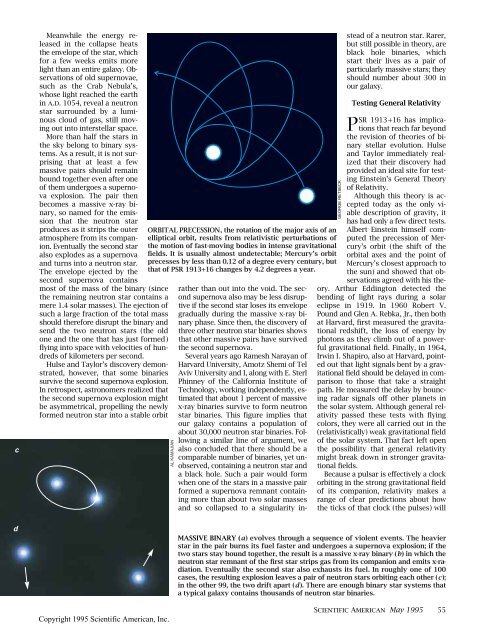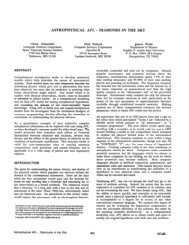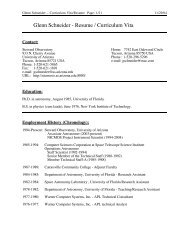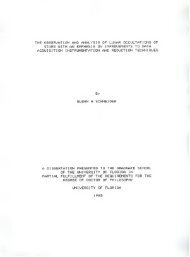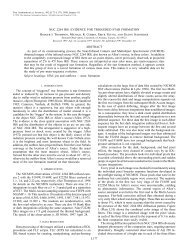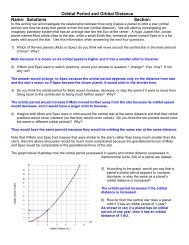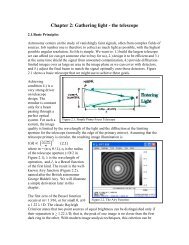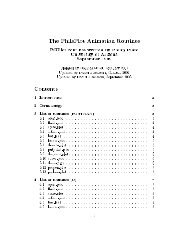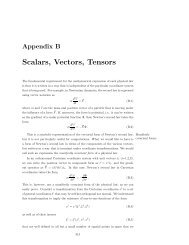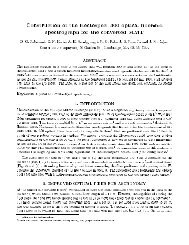Binary Neutron Stars - Scientific American Digital
Binary Neutron Stars - Scientific American Digital
Binary Neutron Stars - Scientific American Digital
Create successful ePaper yourself
Turn your PDF publications into a flip-book with our unique Google optimized e-Paper software.
c<br />
Meanwhile the energy released<br />
in the collapse heats<br />
the envelope of the star, which<br />
for a few weeks emits more<br />
light than an entire galaxy. Observations<br />
of old supernovae,<br />
such as the Crab NebulaÕs,<br />
whose light reached the earth<br />
in A.D. 1054, reveal a neutron<br />
star surrounded by a luminous<br />
cloud of gas, still moving<br />
out into interstellar space.<br />
More than half the stars in<br />
the sky belong to binary systems.<br />
As a result, it is not surprising<br />
that at least a few<br />
massive pairs should remain<br />
bound together even after one<br />
of them undergoes a supernova<br />
explosion. The pair then<br />
becomes a massive x-ray binary,<br />
so named for the emission<br />
that the neutron star<br />
produces as it strips the outer<br />
atmosphere from its companion.<br />
Eventually the second star<br />
also explodes as a supernova<br />
and turns into a neutron star.<br />
The envelope ejected by the<br />
second supernova contains<br />
most of the mass of the binary (since<br />
the remaining neutron star contains a<br />
mere 1.4 solar masses). The ejection of<br />
such a large fraction of the total mass<br />
should therefore disrupt the binary and<br />
send the two neutron stars (the old<br />
one and the one that has just formed)<br />
ßying into space with velocities of hundreds<br />
of kilometers per second.<br />
Hulse and TaylorÕs discovery demonstrated,<br />
however, that some binaries<br />
survive the second supernova explosion.<br />
In retrospect, astronomers realized that<br />
the second supernova explosion might<br />
be asymmetrical, propelling the newly<br />
formed neutron star into a stable orbit<br />
ORBITAL PRECESSION, the rotation of the major axis of an<br />
elliptical orbit, results from relativistic perturbations of<br />
the motion of fast-moving bodies in intense gravitational<br />
Þelds. It is usually almost undetectable; MercuryÕs orbit<br />
precesses by less than 0.12 of a degree every century, but<br />
that of PSR 1913+16 changes by 4.2 degrees a year.<br />
AL KAMAJIAN<br />
GEORGE RETSECK<br />
rather than out into the void. The second<br />
supernova also may be less disruptive<br />
if the second star loses its envelope<br />
gradually during the massive x-ray binary<br />
phase. Since then, the discovery of<br />
three other neutron star binaries shows<br />
that other massive pairs have survived<br />
the second supernova.<br />
Several years ago Ramesh Narayan of<br />
Harvard University, Amotz Shemi of Tel<br />
Aviv University and I, along with E. Sterl<br />
Phinney of the California Institute of<br />
Technology, working independently, estimated<br />
that about 1 percent of massive<br />
x-ray binaries survive to form neutron<br />
star binaries. This Þgure implies that<br />
our galaxy contains a population of<br />
about 30,000 neutron star binaries. Following<br />
a similar line of argument, we<br />
also concluded that there should be a<br />
comparable number of binaries, yet unobserved,<br />
containing a neutron star and<br />
a black hole. Such a pair would form<br />
when one of the stars in a massive pair<br />
formed a supernova remnant containing<br />
more than about two solar masses<br />
and so collapsed to a singularity instead<br />
of a neutron star. Rarer,<br />
but still possible in theory, are<br />
black hole binaries, which<br />
start their lives as a pair of<br />
particularly massive stars; they<br />
should number about 300 in<br />
our galaxy.<br />
Testing General Relativity<br />
PSR 1913+16 has implications<br />
that reach far beyond<br />
the revision of theories of binary<br />
stellar evolution. Hulse<br />
and Taylor immediately realized<br />
that their discovery had<br />
provided an ideal site for testing<br />
EinsteinÕs General Theory<br />
of Relativity.<br />
Although this theory is accepted<br />
today as the only viable<br />
description of gravity, it<br />
has had only a few direct tests.<br />
Albert Einstein himself computed<br />
the precession of MercuryÕs<br />
orbit (the shift of the<br />
orbital axes and the point of<br />
MercuryÕs closest approach to<br />
the sun) and showed that observations<br />
agreed with his theory.<br />
Arthur Eddington detected the<br />
bending of light rays during a solar<br />
eclipse in 1919. In 1960 Robert V.<br />
Pound and Glen A. Rebka, Jr., then both<br />
at Harvard, Þrst measured the gravitational<br />
redshift, the loss of energy by<br />
photons as they climb out of a powerful<br />
gravitational Þeld. Finally, in 1964,<br />
Irwin I. Shapiro, also at Harvard, pointed<br />
out that light signals bent by a gravitational<br />
Þeld should be delayed in comparison<br />
to those that take a straight<br />
path. He measured the delay by bouncing<br />
radar signals oÝ other planets in<br />
the solar system. Although general relativity<br />
passed these tests with ßying<br />
colors, they were all carried out in the<br />
(relativistically) weak gravitational Þeld<br />
of the solar system. That fact left open<br />
the possibility that general relativity<br />
might break down in stronger gravitational<br />
Þelds.<br />
Because a pulsar is eÝectively a clock<br />
orbiting in the strong gravitational Þeld<br />
of its companion, relativity makes a<br />
range of clear predictions about how<br />
the ticks of that clock (the pulses) will<br />
d<br />
MASSIVE BINARY (a) evolves through a sequence of violent events. The heavier<br />
star in the pair burns its fuel faster and undergoes a supernova explosion; if the<br />
two stars stay bound together, the result is a massive x-ray binary (b) in which the<br />
neutron star remnant of the Þrst star strips gas from its companion and emits x-radiation.<br />
Eventually the second star also exhausts its fuel. In roughly one of 100<br />
cases, the resulting explosion leaves a pair of neutron stars orbiting each other (c);<br />
in the other 99, the two drift apart (d). There are enough binary star systems that<br />
a typical galaxy contains thousands of neutron star binaries.<br />
Copyright 1995 <strong>Scientific</strong> <strong>American</strong>, Inc.<br />
SCIENTIFIC AMERICAN May 1995 55


